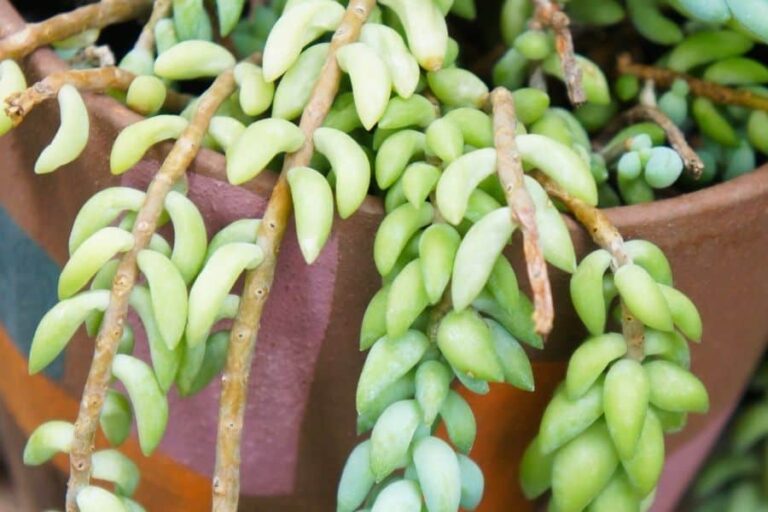Donkey’s tail plant, also known as Sedum morganianum, is a popular trailing succulent with long, hanging stems covered in plump, blue-green leaves. The plant’s unique appearance and low-maintenance care requirements make it a favorite among succulent enthusiasts and beginner gardeners both.
Native to Mexico (just like the Ghost plant) and Honduras, the plant is characterized by its thick, succulent leaves that grow closely together along the stems, resembling the tail of a donkey. This plant is versatile and can be grown in a variety of settings, from hanging baskets to rock gardens, and it can thrive both indoors and outdoors.
Common names for the Donkey’s tail plant:
- Donkey’s tail
- Lamb’s tail
- Burro’s tail
Care
The Donkey’s Tail plant is a pretty low-maintenance plant, so you need to pay attention to just a few details for them to thrive. Basically, just put them in a sunny place and don’t overwater them.
- Soil: To ensure the successful growth of a donkey’s tail plant, you should plant it in well-draining sandy soil (a container with a drainage hole is preferred). The plant thrives in soil with a neutral to alkaline pH.
- Water: If your Donkey’s tail plant is indoors, water it once a month. If you keep it outdoors, watering it every three weeks should do the trick. They just simply hate being overwatered, so definitely avoid that.
- Temperature: The Donkey’s tail plant thrives in warm weather but can tolerate cooler temperatures. An environment of 65-75 degrees Fahrenheit is ideal for the plant, and it should be brought indoors before the first frost.
- Light: The Donkey’s tail plant thrives in warm sunlight, but can tolerate partial shade. We recommend placing it on a sunny windowsill or a partially shaded area outdoors with enough morning sunlight.
Propagation
Donkey’s tail can be easily propagated through its leaves as they fall off easily. Once the leaves have callused over, lay them on top of a cacti or succulent soil mixture and mist regularly until new growth emerges. Be careful not to overwater the young plants.
Pruning
If you’re planning to keep this succulent in a container, choose a sturdy pot that can handle its weight. And if you dare to hang it in a basket, be extra cautious when selecting the perfect pot.
Now, here’s the exciting part. Sometimes your burro’s tail can get a little wild and unruly. Don’t fret! Armed with clean shears, you can trim back those unwanted stems and save them for propagation adventures.
- Assess the plant: Take a close look at your donkey tail plant and identify any leggy or overgrown stems that you want to trim back. Look for stems that appear unhealthy, damaged, or too long.
- Gather your tools: Grab a pair of clean and sharp pruning shears or scissors. It’s important to use sanitized tools to prevent the spread of diseases.
- Plan your cuts: Decide which stems you want to prune and where you want to make the cuts. Keep in mind that donkey tail plants can be delicate, so aim to make clean cuts just above a leaf node or joint.
- Start pruning: Carefully trim back the selected stems, ensuring you’re not removing more than a third of the plant at a time. Prune back to a desirable length or promote a more compact and balanced shape.
- Care for the wounds: After pruning, it’s essential to let the cut ends of the stems dry out and heal. Keep the wounded areas dry to prevent rotting and infection.
Common Pests
Frequently Asked Questions
Donkey’s tail (Burro’s tail) prefers partial sun or some bright shade. Just put it on a sunny windowsill.
Is donkey tail toxic to humans?
Thankfully, donkey’s tail is non-toxic to humans and pets.
Can donkey’s tail survive winter?
Since they are native to Mexico, you should always protect them from frost. If the winter is not very cold in your area, they should be fine.
Do donkey tail plants flower?
Yes, in the summer, donkey’s tail plants bloom with red, yellow or white flowers.
How do I know if my donkey tail needs water?
When you observe that the normally fleshy leaves are beginning to shrink and resemble raisins, it means that your Donkey’s tail plant needs watering.

